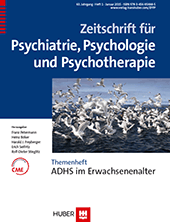Pharmakotherapie bei ADHS im Erwachsenenalter: Eine Bestandsaufnahme
Abstract
Nimmt man heute, im Zeitalter der evidenzbasierten Medizin (EBM), Leitlinien als Maßstab für die medikamentöse Therapie der ADHS im Erwachsenenalter, so hat sich in den vergangenen 10 Jahren wenig verändert: Methylphenidat ist weiterhin auf Platz Nr. 1 und Medikament der ersten Wahl. Einige vielversprechende und in den USA zugelassene Substanzen sind bei uns weiterhin off-label, beziehungsweise im Zulassungsverfahren blockiert. Doch es besteht die berechtigte Hoffnung, dass sich in den kommenden Jahren etwas bewegen wird. Bis zu 80 % der ADHS-Betroffenen haben Komorbiditäten sowohl im psychischen als auch im somatischen Bereich. Aus diesen Gründen ist es hilfreich, wenn mit den neuen Substanzen «zwei Fliegen mit einer Klappe» behandelt werden können, zum Beispiel ADHS und soziale Phobien beziehungsweise ADHS und komorbider Alkoholmissbrauch mit Atomoxetin. Die Erweiterung des pharmakologischen Armamentariums ist auch deshalb dringend notwendig, weil ADHS-Betroffene dank Internet und Chatrooms maßgeschneiderte Lösungen, unbesehen der Vorgaben von EBM, für sich suchen und fordern. Die Integration der medikamentösen Behandlung in einen multimodalen Ansatz entspricht dem heutigen Goldstandard.
In the current age of evidence-based medicine (EBM), taking guidelines as a measuring stick for drug therapy in adult ADHD shows that not much has changed in the past 10 years: methylphenidate is still number one and first-line treatment. Here, some promising drugs available in the US are still off-label or stuck in the admission process, but there’s hope that something will move in coming years. Up to 80 % of individuals with ADHD have both psychic and somatic comorbidities. It is therefore helpful if new drugs can treat “two birds with one stone”, e. g. atomoxetine for ADHD and social phobia, or ADHS and comorbid alcohol abuse. The expansion of the therapeutic armamentarium is urgent also for the reason that individuals with ADHD look to the internet and chat rooms for tailored solutions to their problems, independently of EBM guidelines. The integration of drug treatment into a multimodal approach represents today's gold standard.
Literatur
(2008). Atomoxetine treatment in adults with attention-deficit/hyperactivity disorder and comorbid social anxiety disorder. Depression and Anxiety , 26, 212–221.
(2012). Double-blind controlled trial of venlafaxine for treatment of adults with attention deficit/hyperactivity disorder. Human Psychopharmacology: Clinical and Experimental , 27, 76–81.
(2006). Efficacy and safety of lisdexamfetamine dimesylate [LDX; NRP104] in children aged 6 to 12 years with attention-deficit/hyperactivity disorder. Journal of Developmental and Behavioral Pediatrics , 27, 443–443.
& Study Group (2005). Long-term safety and effectiveness of mixed amphetamine salts extended release in adults with ADHD. CNS Spectrum , 10, 16–25.
(1999). Pharmacotherapy of attention-deficit/hyperactivity disorder reduces risk for substance use disorder. Pediatrics , 104, e20–e20.
(2014). Duloxetine in adults with ADHD: a randomized, placebo-controlled pilot study. Journal of Attention Disorder , 18, 169–175.
(2011). Omega-3 fatty acid supplementation for the treatment of children with attention-deficit/hyperactivity disorder symptomatology: Systematic review and meta-analysis. Journal of the American Association of Children and Adolescence Psychiatry , 50, 991–1000.
(2002). Atomoxetine increases extracellular levels of norepinephrine and dopamine in prefrontal cortex of rat: A potential mechanism for efficacy in Attention Deficit/Hyperactivity Disorder. Neuropsychopharmacology , 27, 699–711.
(2003). ADHS im Erwachsenenalter – Leitlinien auf der Basis eines Expertenkonsensus mit Unterstützung der DGPPN. Der Nervenarzt , 10, 939–946.
(2010). Reboxetine for acute treatment of major depression: systematic review and meta-analysis of published and unpublished placebo and selective serotonin reuptake inhibitor controlled trials. BMJ , 341, c4737–c4737.
(2010). A comparison of the efficacy of medications for adult attention-deficit/hyperactivity disorder using meta-analysis of effect sizes. Journal of Clinical Psychiatry , 71, 754–763.
(2012). Dose response effects of lisdexamfetamine dimesylate treatment in adults with ADHD: an exploratory study. Journal of Attention Disorder , 16, 118–127.
(2011). ADHD medications and risk of serious cardiovascular events in young and middle-aged adults. The Journal of the American Medical Association , 306, 2673–2683.
(2013). Adult ADHD (3rd ed.). Berlin: Springer.
(2006). Pharmakotherapie der Aufmerksamkeitsdefizit-/Hyperaktivitätsstörung (ADHS) im Erwachsenenalter. Zeitschrift für Psychiatrie, Psychologie und Psychotherapie , 54, 99–110.
(2014). ADHS im Erwachsenenalter (4. Aufl.). Stuttgart: Schattauer.
(2013). Clinical response and symptomatic remission in short- and long-term trials of lisdexamfetamine dimesylate in adults with attention-deficit/hyperactivity disorder. BMC Psychiatry , 13, 39–39.
(2008). Attention deficit hyperactivity disorder: Diagnosis and management of ADHD in children, young people and adults . Online unter: www.nice.org.uk/guidance/cg72.
(2012). Stimulants and cardiovascular events in youth with attention-deficit/hyperactivity disorder. Journal of the American Association of Children and Adolescence Psychiatry , 51, 147–156.
(2014). ADHS im Erwachsenenalter. In U. Vorderholzer & F. Hohagen (Hrsg.), Therapie Psychischer Erkrankungen (9. Aufl., S. 399–413). München: Urban & Fischer.
(2001). Efficacy of a mixed amphetamine salts compound in adults with attention-deficit/hyperactivity disorder. Archives of General Psychiatry , 58, 775–782.
(2009). Stahl's illustrated attention deficit hyperactivity disorder . Cambridge: Cambridge University Press.
(2013). A pilot open label prospective study of memantine monotherapy in adults with ADHD. World Journal of Biological Psychiatry , 14, 291–298.
& Study Group (2009). Long-term safety and effectiveness of lisdexamfetamine dimesylate in adults with attention-deficit/hyperactivity disorder. CNS Spectrum , 14, 573–585.
(2005). Long-term cardiovascular effects of mixed amphetamine salts extended release in adults with ADHD. CNS Spectrum , 10, 35–43.
, … Study Group (2006). Mixed amphetamine salts extended-release in the treatment of adult ADHD: A randomized, controlled trial. CNS Spectrum , 11, 625–639.
, … Atomoxetine ADHD/SUD Study Group (2008). Atomoxetine treatment of adults with ADHD and comorbid alcohol use disorders. Drug Alcohol Depend , 96, 145–154.
(2005). Bupropion XL in adults with attention-deficit/hyperactivity disorder: A randomized, placebo-controlled study. Biological Psychiatry , 57, 793–801.



